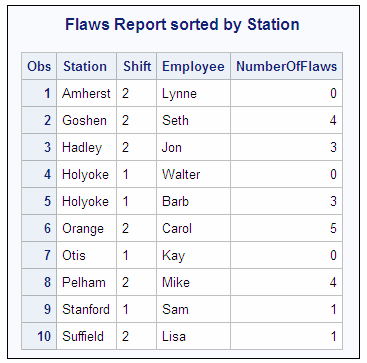About Creating a SAS Data Set with a DATA Step
Creating a SAS Data File or a SAS View
You can create either a SAS
data file, a data set that holds actual data, or a SAS view, a data
set that references data that is stored elsewhere. By default, you
create a SAS data file. To create a SAS view instead, use the VIEW=
option in the DATA statement. With a SAS view, you can process current
input data values without having to edit your DATA step. For example,
you can process monthly sales figures without having to edit your
DATA step. Whenever you need to create output, the output from a SAS
view reflects the current input data values.
Sources of Input Data
Reading Raw Data: Examples
Example 1: Reading External File Data
The components of a DATA step that produce a SAS data
set from raw data stored in an external file are outlined here.
data Weight; 1 infile 'your-input-file'; 2 input IDnumber $ week1 week16; 3 WeightLoss=week1-week16; 4 run; 5 proc print data=Weight; 6 run; 7
| 1 | Begin the DATA step and create a SAS data set called WEIGHT. |
| 2 | Specify the external file that contains your data. |
| 3 | Read a record and assign values to three variables. |
| 4 | Calculate a value for variable WeightLoss. |
| 5 | Execute the DATA step. |
| 6 | Print data set WEIGHT using the PRINT procedure. |
| 7 | Execute the PRINT procedure. |
Example 2: Reading Instream Data Lines
data Weight2; 1 input IDnumber $ week1 week16; 2 AverageLoss=week1-week16; 3 datalines; 4 2477 195 163 2431 220 198 2456 173 155 2412 135 116 ; 5 proc print data=Weight2; 6 run;
| 1 | Begin the DATA step and create SAS data set WEIGHT2. |
| 2 | Read a data line and assign values to three variables. |
| 3 | Calculate a value for variable WeightLoss2. |
| 4 | Begin the data lines. |
| 5 | Signal end of data lines with a semicolon and execute the DATA step. |
| 6 | Print data set WEIGHT2 using the PRINT procedure. |
| 7 | Execute the PRINT procedure. |
Example 3: Reading Instream Data Lines with Missing Values
You can also take
advantage of options in the INFILE statement when you read instream
data lines. This example shows the use of the MISSOVER option, which
assigns missing values to variables for records that contain no data
for those variables.
data weight2; infile datalines missover; 1 input IDnumber $ Week1 Week16; WeightLoss2=Week1-Week16; datalines; 2 2477 195 163 2431 2456 173 155 2412 135 116 ; 3 proc print data=weight2; 4 run; 5
| 1 | Use the MISSOVER option to assign missing values to variables that do not contain values in records that do not satisfy the current INPUT statement. |
| 2 | Begin data lines. |
| 3 | Signal end of data lines and execute the DATA step. |
| 4 | Print data set WEIGHT2 using the PRINT procedure. |
| 5 | Execute the PRINT procedure. |
Example 4: Using Multiple Input Files in Instream Data
This example shows how to
use multiple input files as instream data to your program. This example
reads the records in each file and creates the ALL_ERRORS SAS data
set. The program then sorts the observations by Station, and creates
a sorted data set called SORTED_ERRORS. The print procedure prints
the results.
data all_errors;
length filelocation $ 60;
input filelocation; /* reads instream data */
infile daily filevar=filelocation
filename=daily end=done;
do while (not done);
input Station $ Shift $ Employee $ NumberOfFlaws;
output;
end;
put 'Finished reading ' daily=;
datalines;
pathmyfile_A
pathmyfile_B
pathmyfile_C
;
proc sort data=all_errors out=sorted_errors;
by Station;
run;
proc print data = sorted_errors;
title 'Flaws Report sorted by Station';
run;Reading Data from SAS Data Sets
Generating Data from Programming Statements
You can create data for a SAS
data set by generating observations with programming statements rather
than by reading data. A DATA step that reads no input goes through
only one iteration.
data investment; 1 begin='01JAN1990'd; end='31DEC2009'd; do year=year(begin) to year(end); 2 Capital+2000 + .07*(Capital+2000); output; 3 end; put 'The number of DATA step iterations is '_n_; 4 run; 5 proc print data=investment; 6 format Capital dollar12.2; 7 run; 8
| 1 | Begin the DATA step and create a SAS data set called INVESTMENT. |
| 2 | Calculate a value based on a $2,000 capital investment and 7% interest each year from 1990 to 2009. Calculate variable values for one observation per iteration of the DO loop. |
| 3 | Write each observation to data set INVESTMENT. |
| 4 | Write a note to the SAS log proving that the DATA step iterates only once. |
| 5 | Execute the DATA step. |
| 6 | To see your output, print the INVESTMENT data set with the PRINT procedure. |
| 7 | Use the FORMAT statement to write numeric values with dollar signs, commas, and decimal points. |
| 8 | Execute the PRINT procedure. |
